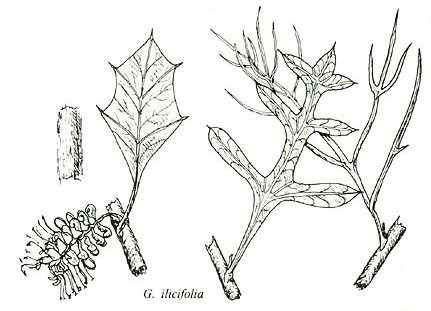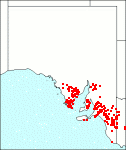Family: Proteaceae
Grevillea ilicifolia
Citation:
R. Br., Suppl. Primum Prod. Fl. Nov. Holl. Prot. Nov. 21 (1830).
Synonymy: Anadenia ilicifolia R. Br., Trans. Linn. Soc. 10:167 (1810); Grevillea ilicifolia (R. Br.)R. Br. a. attenuata R. Br., Suppl. Primum Prod. Fl. Nov. Holl. Prot. Nov. 21 (1830); Grevillea ilicifolia (R. Br.)R. Br. (. dilatata R. Br., Suppl. Primum Prod. Fl. Nov. Holl. Prot. Nov. 21 (1830); Grevillea lobata F. Muell., Trans. Phil. Soc. Vic. 1:22 (1854); Grevillea ilicifolia (R. Br.)R. Br. var. lobata ( F. Muell.)Benth., Fl. Aust. 5:438 (1870): Grevillea ilicifolia (R. Br.)R. Br. var. angustiloba F. Muell., Fragm. Phyt. Aust. 6:212 (1868).
Common name: Holly-leaved grevillea, holly-bush, holly grevillea, holly-leaved spider-flower.
Description:
Procumbent to erect spreading shrub to 2 m high: branchlets persistently appressed-pubescent, with 3 ribs decurrent from each leaf rarely glabrescent; leaves rigid, very variable, glabrescent above, densely appressed-pubescent below, with midrib and veins prominent, obovate-cuneate and almost entire to undulate to sharply or bluntly lobed, 1.5-7 X 1-4 cm, with 3-10 lobes, grading to pinnatipartite or bipinnatipartite, 3.5-11 cm long, with 7-18 final segments 0.5-3.5 cm X 0.7-2.5 ram, with petiole 1.5-5 cm long, the lobes always spiny, the margin between narrowly recurved racemes subterminal on short axillary branchlets, unilateral, densely 10-20-flowered, with flower-subtending bracts c. 1 mm long, caducous early.
Rhachis, pedicel and perianth externally appressed-pubescent, the perianth sometimes sparsely, rhachis 1.5-3.5 cm long: flowers subsessile: torus slightly oblique to horizontal; perianth 5-9.5 mm long, green, splitting fully down one side only, limb recurved gland horseshoe-shaped, obscured by torus: ovary and sometimes the stipe white-sericeous; style 17-20 mm long, glabrous, red, rarely yellow, dilated on lower side only into an oblique concave pollen-presenter with a short central cone.
Fruit obliquely ovoid compressed, 10-14 mm long, obliquely inserted on the stipe, appressed-pubescent, with an obliquely inserted persistent glabrous style.

| portion of a branchlet, flowers with a broad leaf form and two other leaf forms
|
Image source: fig. 69d in Jessop J.P. & Toelken H.R. (Ed.) 1986. Flora of South Australia (4th edn).
|
Published illustration:
Costermans (1981) Native trees and shrubs of south-eastern Australia, p. 165.
|
|
Distribution:
|
In deep sand, sand overlying limestone, clay fiats and swampy depressions, in sclerophyllous heath or woodland.
N.S.W.; Vic.
|
Conservation status:
native
Flowering time: Aug. — Nov.
|

SA Distribution Map based
on current data relating to
specimens held in the
State Herbarium of South Australia
|
Biology:
Very closely allied to Grevillea aquifolium. Three varieties representing some of the extremes in leaf variation are sometimes recognised (see Fig. 69D), although there seems to be common intergradation between each. The leaves of var. ilicifolia, occurring throughout the range of the species in S.Aust., are entire or only shallowly lobed; var. lobata (F. Muell.)Benth., known from S.Aust.: MU, SL, SE, has narrower lanceolate lobes; forms in S.Aust. (SL, SE) attributable to var. angustiloba F. Muell., Fragm. Phyt. Aust. 6:212 (1868) have long very narrow and distant leaf segments. Fig. 69D, plate 5.
Author:
Not yet available
|

